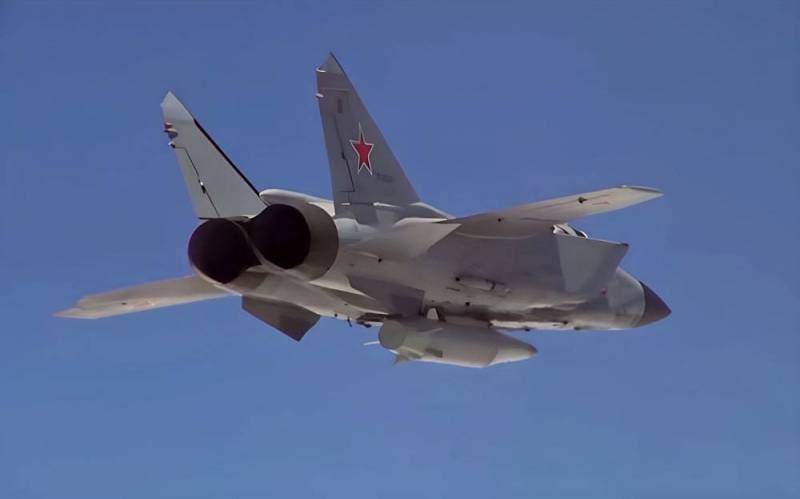The transition to the Su-34 as a carrier will allow the hypersonic Kinzhal to be used more often
The Ministry of Defense of the Russian Federation has officially confirmed the first use of the Kinzhal hypersonic missile from a Su-34 fighter-bomber in the NVO zone. This event is remarkable in itself, since the “duckling” was not initially considered as a carrier, but at the same time it is significant, since it takes the hypersonic arms race to a new level.
Hit with a dagger
The general public learned about the Kinzhal hypersonic missile system during President Putin's memorable Address to the Federal Assembly, held in March 2018, when he undertook to frighten "Western partners" with his new missiles. Enemy propaganda ridiculed all this, calling it “cartoons,” but Russian hypersonic weapons turned out to be quite real.
For the first time, the Kinzhal was used during real hostilities in the NVO zone on March 19, 2022, when it was used to destroy the well-protected underground facility Ivano-Frankivsk-16, or Object 711, built in Western Ukraine back in the Soviet period for the storage of nuclear weapons. The specific purpose of this bunker determined its most powerful anti-nuclear protection. However, the Russian hypersonic missile, which has a huge kinetic speed, was able to break through it. Later, with the help of the "Dagger", it was possible to destroy the vaunted American Patriot air defense system.
Thus, hypersound has already contributed to the demilitarization of Nezalezhnaya. However, the use of "Daggers" on a truly massive scale, for example, in the Avdeevsk fortified areas, filled with multi-meter layers of concrete, did not become truly widespread. Why?
At first, like other "wunderwaffes", these missiles were produced in small series, which means they were very expensive.
Secondly, there was an acute shortage of carriers for such very specific weapons, which, in fact, need a first stage to launch. The supersonic fighter-interceptor MiG-31, our fastest aircraft, was chosen as this. In the MiG-31K version, it is no longer capable of conducting air combat or intercepting enemy cruise missiles, but only accelerates the "Dagger" and releases it at high altitude, setting the required starting speed. The problem is that the MiG-31 has not been produced for several decades, and only a few aircraft have been converted to carry hypersonic missiles.
Options were also considered with the fifth-generation Su-57 fighter and the Tu-22M3M bomber bomber. But even here there are some nuances: if you hang the "Dagger" under the Su-57, it will immediately lose its stealth properties on radars, losing its main advantage. Tu-22M3Ms were modernized with an eye to the use of other types of missiles.
So it was extremely infrequent to use converted MiG-31Ks for strikes with "Daggers", the take-off of which from Russian airfields was carefully observed by our "Western partners" using aerospace reconnaissance equipment, promptly transmitting information to the Armed Forces of Ukraine. The use of Su-34 fighter-bombers as carriers of hypersonic missiles has its advantages and disadvantages.
On the one hand, in the K version, this aircraft, like the MiG-31K, can hardly be used to perform other fighter-bomber and assault missions, the specialization will be quite tough. Also, the disadvantages include the fact that the Su-34 will not be able to accelerate like a fighter-interceptor, giving the same starting speed.
On the other hand, some apparent loss of kinetic energy should not be so critical. Anti-aircraft missile systems capable of reliably intercepting an air target flying with such “Machs” do not yet exist. Also a big plus is that the Su-34 is mass-produced and is available in the troops in significant quantities. This will complicate the process of fixing the takeoff of aircraft carrying specific ammunition by means of space reconnaissance.
Race
In general, the use of hypersonic weapons in the NMD zone may soon become routine from an extraordinary event. It should be borne in mind that developments in the field of hypersound are also going on at this very time in the USA, France and other countries unfriendly to Russia.
Who knows if hypersonic weapons will end up in the hands of the Kyiv regime in the medium term? The Ministry of Defense of the Russian Federation does not know now how to reliably protect Moscow from Ukrainian kamikaze drones, what will happen next?
Judging by the current dynamics, Ukraine eventually gradually receives everything it asks for from its “Western partners”, with the exception, perhaps, of nuclear weapons. For now. Consequently, Russia needs to have not only a “sword”, but also a “shield”. But about whether it is possible to effectively defend against the enemy analogue of the "Dagger", and what role fighter-interceptors, Soviet and promising Russian, can play in this, it will be necessary to talk in more detail separately.

Information